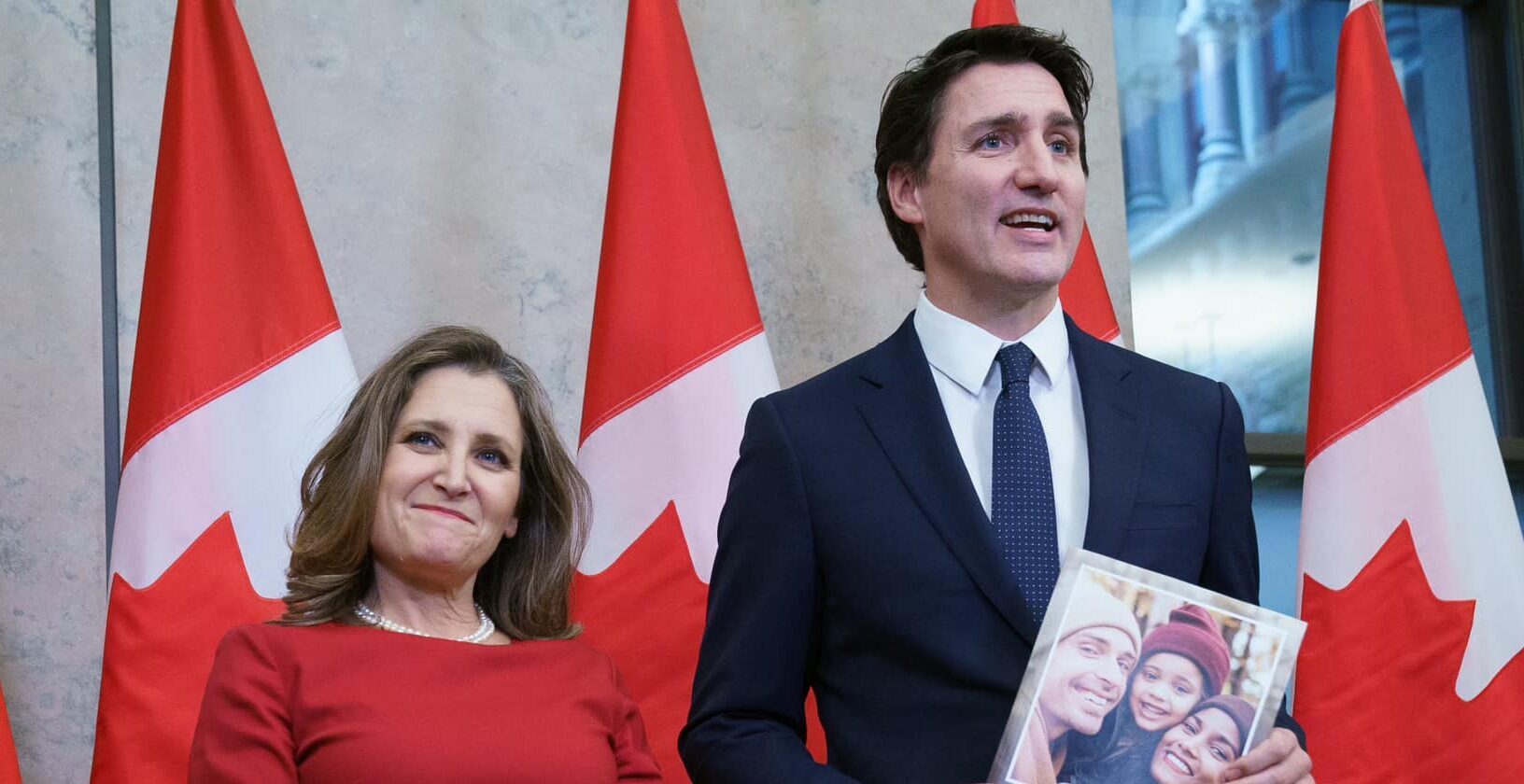Most cabinet ministers known to fewer than half of all Canadians
November 20, 2017 – In parliamentary tradition, prime ministers are sometimes referred to as primus inter pares, Latin for “first among equals” relative to other members of their cabinet.
But the latest public opinion research from the Angus Reid Institute indicates this country’s federal cabinet ministers are hardly equal when it comes to recognition or awareness among Canadians.
Of 30 cabinet members, two-thirds are unknown to at least half the country. Indeed, they are so unrecognized that respondents were unable to render any opinion on whether these ministers of the Crown are doing a good or a bad job.
Among the better-known ministers, those responsible for trade, public safety and defence receive the highest marks. On the other end of the scale, months of criticisms over policy, performance and public transparency has put the finance minister at the back of the pack. Notably, not one member of cabinet receives a “good job” designation from more than 50 per cent of respondents.
More Key Findings:
- Canadian awareness of the federal cabinet is low. Just five of the 30 ministers are recognized by six-in-ten respondents. Minister of Finance Bill Morneau and Defense Minister Harjit Sajjan are the most well-known.
- While Morneau is the most recognizable face of the federal cabinet, he is also the most negatively received. Just 23 per cent of those who are aware of him say he is doing a good job – 46 per cent say the opposite
- Considering each member’s ‘Performance Score’ – that is, the percentage who say each is doing a “good job” minus the percentage who say “bad job” – Minister of Public Safety and Emergency Preparedness Ralph Goodale (24%) and Minister of Foreign Affairs Chrystia Freeland (23%) score highest.
INDEX:
-
It really is the ‘Trudeau Government’
-
The Recognizable Faces
-
The Middle Ministers
-
The Relative Unknowns
-
The Partisan Factor
-
The Gender Factor
-
High scores for Governor General, Speaker, Chief Justice
-
Notes on Methodology
It really is the ‘Trudeau Government’
When it comes to the federal government, there’s no question who the face and spokesperson is. From GQ covers to dinner with Ellen, Prime Minister Justin Trudeau is front and centre, and generally well approved of by the Canadian public. At the two-year mark, he has yet to dip below majority approval.
While Trudeau is no stranger to the spotlight, most of his cabinet toils far away from it, maintaining a relatively low profile – at least – when it comes awareness in the Canadian consciousness. Twenty of 30 ministers are unknown to roughly half of Canadians.
The Recognizable Faces
Only five cabinet ministers are known by more than six-in-ten Canadians. At the top is Finance Minister Bill Morneau, though perhaps not for the reasons he would like. In recent months, opposition critics have accused Morneau of ethics violations after media reports he did not place his business assets in a blind trust when he took his position in the government in 2015. The Prime Minister has defended Morneau, who claims that he followed protocol dictated by the ethics commissioner.
Related: Canadian entrepreneurs see changes to passive investment rules as ‘unfair’ by 2:1 margin
The 10 most well-known ministers are shown in the table that follows.

The minister receiving the most praise from the Canadian public on the whole is Foreign Affairs Minister Chrystia Freeland. Renegotiations of the North American Free Trade Agreement have occupied much of Freeland’s bandwidth over the course of 2017, and it appears Canadians are happy with her performance to this point. Twice as many Canadians (46%) say that Freeland has done a good job in her post, compared to those who say she’s done badly (23%).
Placing just behind Freeland is Minister of Public Safety and Emergency Preparedness Ralph Goodale. Forty-five per cent of Canadians say he’s done a good job at the two-year mark of the Trudeau government’s expected term. Goodale is widely respected in Ottawa, having first served in parliament in 1974, and been named a minister in the Chretien, Martin and Trudeau governments.
Minister of National Defence Harjit Sajjan receives a good job performance assessment from four-in-ten Canadians. Sajjan faced criticism early in 2017 for embellishing his role in a key operation in Afghanistan, but appears to have settled into favour with many Canadians. Under Sajjan’s tenure, the government has withdrawn Canadian fighter jets from anti-ISIS operations in the Middle East, tripled Canada’s special forces for training local troops, and released a new defence policy. The government also recently announced its commitment to offer equipment, training and 200 ground troops for future UN peacekeeping operations.
Canadians appear ambivalent about ministers Seamus O’Regan and Jane Philpott. Each has a roughly equal number saying they are doing a good and a bad job, and a large portion saying they have a mixed view.
Two of the 10 most-known ministers have an overall negative performance rating – Minister of Finance Bill Morneau and Minister of Immigration, Refugees and Citizenship Ahmed Hussen. Fewer than one-in-four Canadians (23%) say Morneau is doing a good job, while almost twice as many say he has done a poor job (43%).
Hussen’s negative rating may stem in part from the file he oversees. From debates over initial refugee settlement targets during the election campaign to a surge in asylum seekers over the summer, this issue has been top-of-mind for many Canadians over the last two years. The government’s immigration and refugee policy – which includes a target of 300,000 new immigrants per year, including 40,000 refugees – is one of the least popular items in the Trudeau compendium after two years. Three-in-ten Canadians (31%) applaud the job done by Hussen, while 37 per cent are unsatisfied.

The Middle Ministers
The second group – the middle 10 in terms of awareness – features ministers who are recognizable to between four-in-ten and half of Canadians.

Among the middle-ranking ministers in awareness, Minister of Justice Jody Wilson-Raybould receives the highest performance score and the highest level of awareness. Minister of Natural Resources Jim Carr receives the lowest score, at a -8.

The Relative Unknowns
The least well-known member of the cabinet is Minister of Democratic Institutions, Karina Gould, of whom only 29 per cent of Canadians offered an opinion. At 30 years of age (29 when she was appointed), Gould has the distinction of being the youngest female cabinet minister in Canadian history.
The following table shows the 10 least-known and recognized members of cabinet, and the assessment of their performance among Canadians who are aware of them:
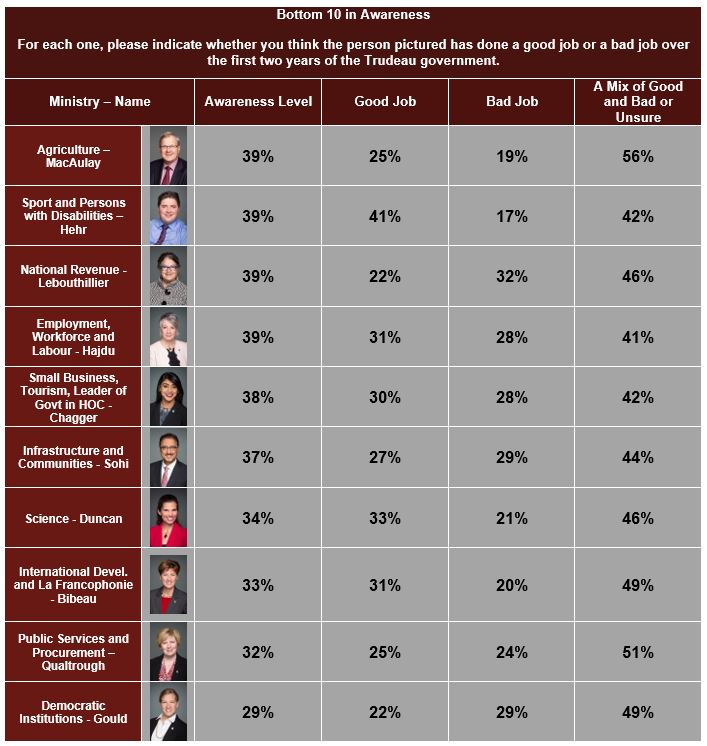
Though relatively unknown among most Canadians, Minister of Sport of Sport and Persons with Disabilities Kent Hehr, is seen to be doing good work by four-in-ten Canadians, and his performance score ranks first overall, alongside Ralph Goodale.
Minister of National Revenue Diane Lebouthillier ranks lowest on the list in terms of job approval. Perceptions of her job performance may well be suffering due to ongoing problems with the government’s Phoenix payment system, which has caused significant financial trouble for thousands of government employees over the past two years.

The Partisan Factor
Political partisanship is a significant factor in driving opinion of cabinet members. For example, half of past Conservative voters say Harjit Sajjan has done a bad job (49%), while six-in-ten Liberal voters say the opposite (61%). The following table shows how each of the ten best-known ministers fare among their own base, relative to past non-Liberal voters. For such results for all cabinet members, see comprehensive tables.
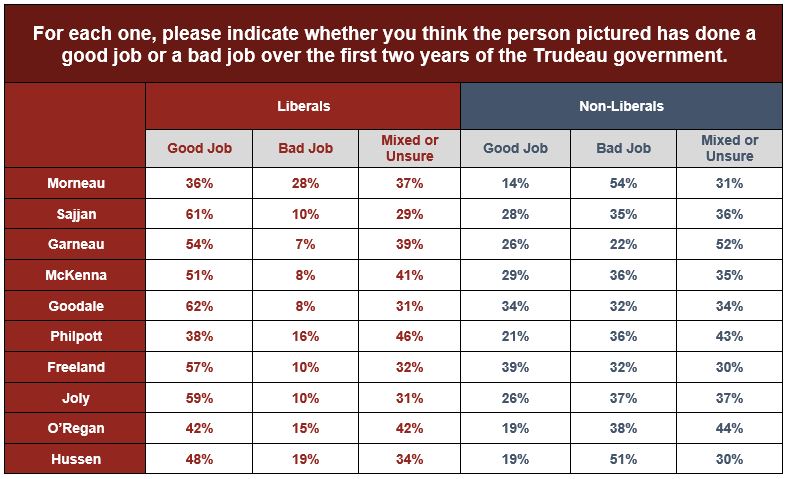
The Gender Factor
Another noteworthy element of this study is the apparent propensity of men to be more negative about all members of cabinet. Men are more likely than women to say each of the 30 ministers is doing a bad job. The two most stark examples are Minister of Immigration, Refugees and Citizenship Ahmed Hussen, and Minister on the Status of Women Maryam Monsef. In both cases, men are significantly more inclined than women to say each minister is doing a bad job.
In all but one of the ten most disparate cases, women are more likely to say each minister is doing a good job than men:

Indeed, while male respondents are more negative overall, this survey finds they are especially negative toward female ministers. The average difference in ‘bad job’ opinion between men and women when looking at the 15 male ministers is +11.2 percentage points. For the 15 female ministers it jumps to +14.9 percentage points.
High scores for Governor General, Speaker, Chief Justice
In addition to cabinet members, the Angus Reid Institute asked about three other individuals whose mandates and roles are independent from the Liberal government. Notably, of the 33 people on whom opinions were canvassed in this survey, newly appointed Governor General Julie Payette – who has held her post for about six weeks – is among the most recognizable faces.
Three-quarters of Canadians (76%) say they are aware of her, significantly more than are aware of Speaker of the House of Commons Geoff Regan and Supreme Court Justice Beverly McLachlin, who has held her position for 17 years. Awareness of Payette can likely be credited to her past career as an astronaut. She also recently generated some debate over the traditionally apolitical role of the Governor General, after she scoffed at climate change skeptics at a science conference.
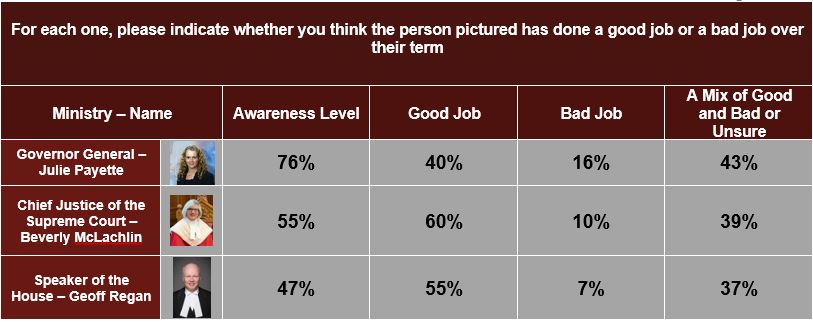
The partisanship that defines most of the responses regarding ministers of the cabinet is significantly less evident when looking at two of these individuals – the Chief Justice and the Speaker of the House. Non-Liberals however, though they are net positive about the Governor General, are significantly less likely than Liberals to say that she is doing a good job.

Notes on methodology
The Angus Reid Institute separated the 30 members of the federal Liberal cabinet into three groups. Each group was shown to a randomized sample of just over 800 Canadians for a total of 2425 responses. Each individual respondent was asked to rate the performance of 10 cabinet members, marking each as having done a “good job,” “bad job,” or “a mix of good and bad” over the first two years of the Trudeau government. Respondents who were unfamiliar with a given minister were asked to indicate as much.
Each group of ministers was balanced for gender and regional representation. The groups are shown in the table that follows.
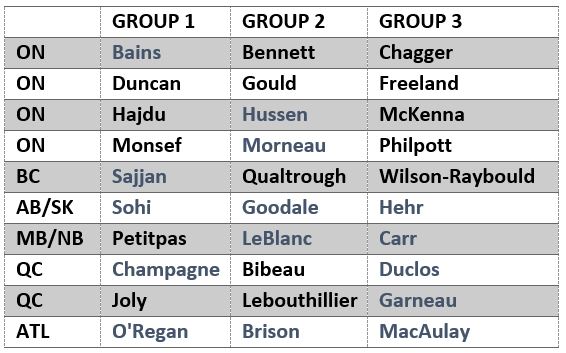
Male
Female
The Angus Reid Institute (ARI) was founded in October 2014 by pollster and sociologist, Dr. Angus Reid. ARI is a national, not-for-profit, non-partisan public opinion research foundation established to advance education by commissioning, conducting and disseminating to the public accessible and impartial statistical data, research and policy analysis on economics, political science, philanthropy, public administration, domestic and international affairs and other socio-economic issues of importance to Canada and its world.
For detailed results by age, gender, region, education, and other demographics, click here.
For detailed results that exclude those who said ‘Don’t Know’, click here.
Click here for the full report including tables, sample size and methodology
Click here for the questionnaire used in this survey
MEDIA CONTACTS:
Shachi Kurl, Executive Director: 604.908.1693 shachi.kurl@angusreid.org @shachikurl



